The history of piercing goes back at least as far as the oldest human mummy, and has taken many odd but often beautiful turns along the way.
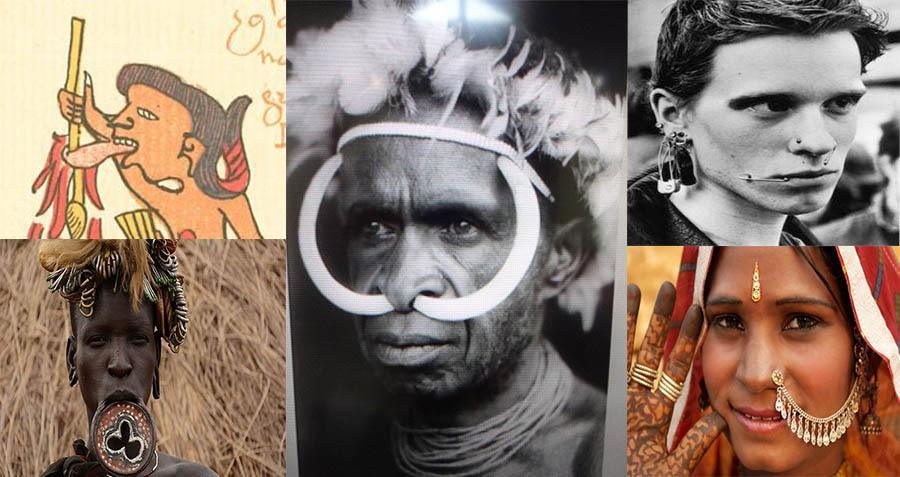
Body piercing has existed across time and culture.
Chances are, even if you don’t have a single piercing on your body, you know someone who does. It’s a common beauty technique and even a form of self expression, but where did it come from? Who first decided to start poking holes in their bodies, and why did they do it?
Let’s begin 5,300 years ago, with the oldest mummified person found to date, and see what he and his descendants can tell us…
Ear Piercings
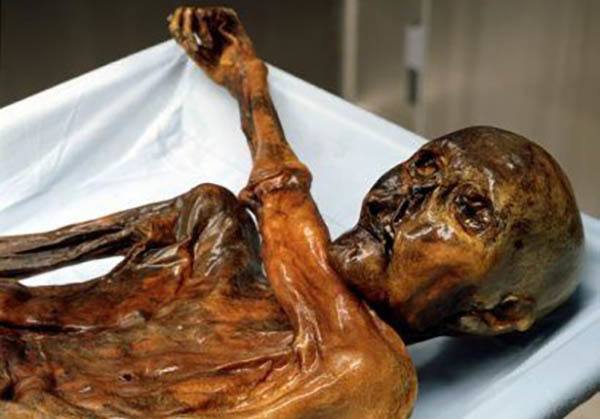
Ötzi – the 5,300-year-old mummy – was found to have had his ears pierced. Image Source: Wikipedia
When the body of Ötzi — the oldest mummy ever found – was discovered by two tourists in 1991 on the border between Austria and Italy, he was found to have pierced ears, the holes gauged 7-11mm in diameter. It is believed that Ötzi lived around 3,300 BC, so it’s clear that ear piercing has been a relatively constant and important part of our culture almost since the dawn of humanity.
Traveling forward nearly 2,000 years to the age of King Tut, the trend was still going strong, with the boy king (whose reign lasted from 1332-1323BC) also displaying evidence of wearing earrings, alongside many other Ancient Egyptians.
Heading another 1,300 years into the future (and a little further west), earrings continued to reign as a (largely male) style accessory in Ancient Rome, with Julius Caesar himself bringing them into fashion during his reign from 49-44BC. And during the Elizabethan era of late 16th century Britain, any man of nobility had at least one ear piercing to show off his wealth.
It wasn’t just the rich and the powerful who pierced their ears, either, and it wasn’t always purely decorative: Sailors from many different eras would often pierce their ears, knowing that if they were to die at sea, the earring recovered from their body could pay for a funeral.
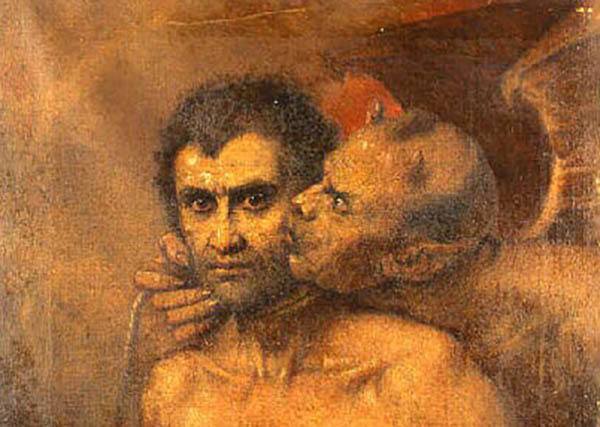
Conventional wisdom for some time said that demons would enter the body through the ear, and metal warded against them. Image Source: WordPress
Despite the way earrings would be flaunted across the centuries, the practice began in primitive tribes for superstitious reasons. People believed that demons could enter the body through the ears, but that they were repelled by metal: Thus, earrings were a protection against possession.
Nose Piercings

An Indian woman dons a nose ring. Image Source: Pathos
The first recorded mention of nose rings is in Genesis 24:22. When Abraham decides to find a wife for his son Isaac, he chooses Rebekah, and gives her a gold nose ring to seal the deal.
According to The Naked Woman: A Study of the Female Body by Desmond Morris, “it is still a common practice among the Berber and Bedouin peoples of North Africa and the Middle East, where the husband gives his bride a gold nose ring when they are married. The size of the ring indicates the wealth of the family, and, if a divorce occurs later, the rejected wife can use the gold in her nose to provide her with financial security.”
Mughal emperors brought the practice to India in the 16th century. A stud or ring is often worn in the left nostril by women, as the left side is associated with female reproductive organs. The piercing is supposed to lessen the pain of birth and menstruation.
Nose piercings didn’t reach the West until the 1960s and 1970s, when hippies started traveling to India, and were taken up by the punk movement in the ’70s as a sign of nonconformity.
Septum Piercings
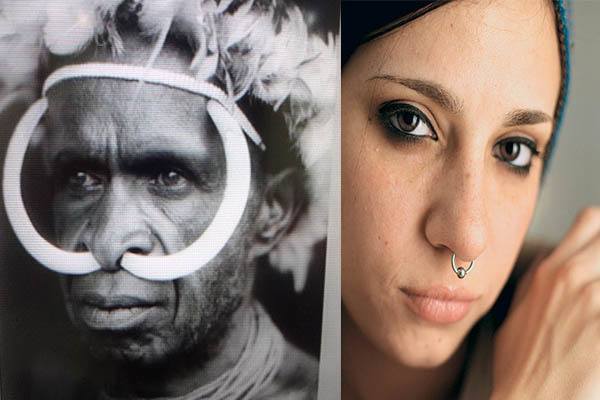
Septum piercings are common across many cultures. Left, a member of the Asmat tribe. Right, an American woman.
Septum piercings are quite common among tribal peoples, often used to make warrior men look fierce. The Asmat tribe in Irian Jaya, Indonesia will stretch these piercings to as much as 25mm in diameter, allowing for the leg bone of a pig or the femur of a killed enemy to be placed within it.
The Aztecs, Mayans, and Incas pierced their septums with gold and jade to symbolize the water and sun gods, a practice still kept up by the modern day Cuna Indians in Panama.
In India, Nepal, and Tibet, an amulet called a bulak is attached to the piercing, often so big that it has to be lifted so that the person with the piercing can eat. It is believed that piercing the nose prevents infection, though the bulak itself seems to be purely ornamental — and the bigger, the better.
Among the Aborigines in Australia, the piercing is used to flatten the nose and therefore make it more “beautiful.”
Tongue Piercings
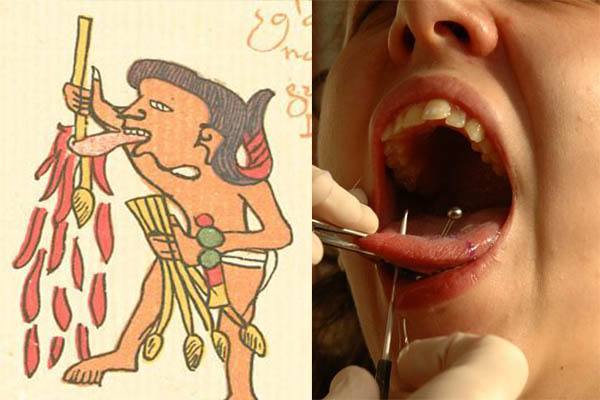
Not much has changed since Aztec times. Image Source: WordPress
Between the 14th and 16th centuries, tongue piercings originated as a ritual among the Aztecs and Mayans as a form of blood sacrifice. They would often pass a thread through the piercing to enhance the flow of blood. Priests and shamans in these cultures would also pierce their own tongues to create an altered state of consciousness so they could communicate with the gods.
20th century carnies learned about tongue piercings from religious ascetics, and would perform them as a sideshow attraction. Its resurgence came in the 1980s, with the opening of Gauntlet in LA, the first professional piercing shop in the US. Elayne Angel, who founded Gauntlet, is often credited with promoting the piercing, both for shock value and for the enhancement of oral sex.
Lip Piercings
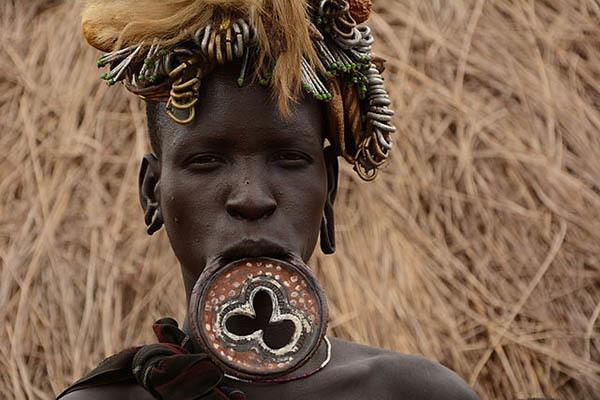
A Morsi tribeswoman dons a lip plate in Ethiopia.
Lip piercings are most common in tribal cultures, though only two tribes in Africa (the Dogon and Nuba) use rings. Most use labrets (bars with balls attached at either end) or plates.
Dogons pierce their lips to represent the creation of the world. In their mythology, the goddess Noomi wove thread through her teeth, but when it came out, the thread was transformed into speech.
In other cultures, lip piercings are a marriage ritual. Makololo tribal women wear plates in their upper lip to make themselves more beautiful. They’re often inserted by a woman’s husband-to-be as a betrothal rite six months before marriage, and the size of the plate correlates to her dowry.
Navel Piercings
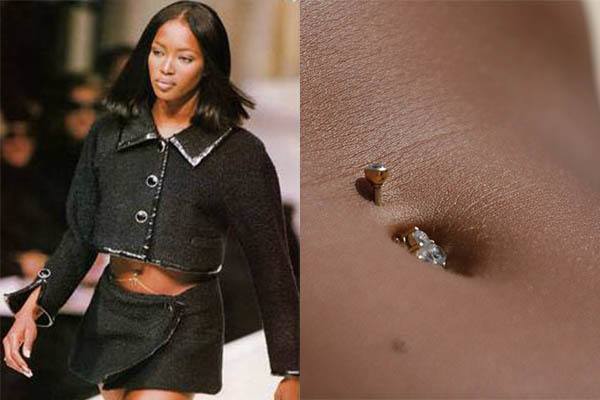
Naomi Campbell may have helped bring the navel piercing back to life in the early ’90s. Image Source: Wikipedia
In Ancient Egypt, this piercing was a sign of royal status — only the pharaoh was allowed to have his navel pierced and anyone else found with this piercing would be executed.
Millennia later, when bikinis came into fashion, the navel was at first considered scandalous because — believe it or not — of its similarity to the vagina. The piercing and showing off of the belly button remained fairly taboo, at least up until the early 90s, when Christy Turlington sported one in a London fashion show in 1993. Naomi Campbell and Madonna quickly followed suit, and soon the navel piercing became one of the more popular fads of the era.
Nipple Piercings
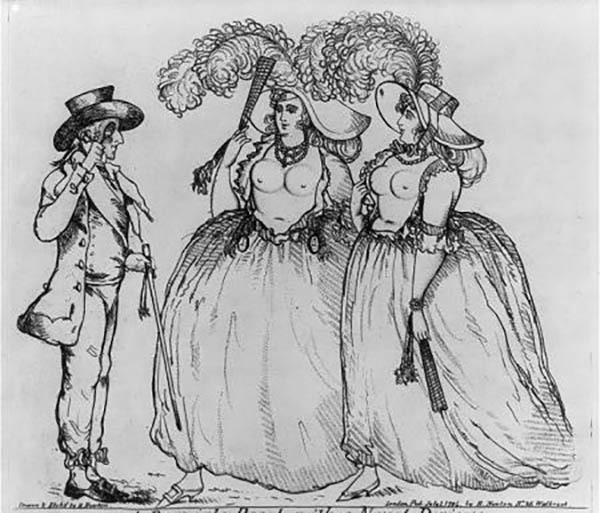
The “Garments of the Grand Neckline” dress.
In Ancient Rome, men pierced their nipples to symbolize virility and their camaraderie with other men. Only later did it become a woman’s practice.
In the mid-14th century, Queen Isabella of France introduced “garments of the grand neckline,” dresses with such low necklines — sometimes to the navel — that the nipples were often openly displayed. As such, nipple piercing became a form of jewelry to match the dress.
In the 1890s, the “bosom ring” came back into vogue. These often expensive rings enlarged the nipples and caused them to be easily pleasured, which brought much excitement to high class women. According to one socialite of the time, “with regard to the experience of wearing these rings, I can only say that they are not in the least uncomfortable or painful. On the contrary, the slight rubbing and slipping of the rings causes in me an extremely titillating feeling, and all my colleagues I have spoken to on this subject have confirmed my opinion.”
Meanwhile, in Victorian England, doctors would recommend nipple piercings to enhance the size of the nipples and make breastfeeding easier.
Genital Piercings

Image Source: Photospin
The beginnings of clitoral piercings are generally unknown, but the history of male genital piercings is well documented.
In Ancient Greece, foreskin piercings would be tied with a thong to the base of the penis to keep the genitals out of the way during sport and combat. It was also used to keep slaves from having sex in both Greece and Rome.
Apadravya piercings are mentioned in the Kama Sutra, and date back to 700AD, while the palang — a piercing made across the surface of the glans — has been practiced in southeast Asia for hundreds of years. In Borneo, the palang symbolizes the protective power of a man over his family, but both piercings are used for sexual pleasure.
Guiche piercing originated in Polynesia, and was typically done by a Mahu, or a well-respected man who dressed as a woman. After the piercing healed, a shell or rock would be hung from it.
The “Prince Albert” piercing was supposedly named for Queen Victoria’s husband.
The popular legend claims that he had it done before their marriage in 1825, apparently in order to conceal the unsightly bulge in his fashionably tight trousers — the myth further states that the piercing attached to a hook on the inside of his pants. None of this has been found to be true, of course, and most of it stems from a fanciful history concocted by the piercing’s real inventor, Jim Ward — often described as the “grandaddy of the modern body piercing movement” — and his friend Doug Malloy in the early 1970s.
Today, genital piercing mostly relates directly to sexual culture, especially in the West.
Next, check out the world’s most interesting mating rituals as well as extreme acts of body modification.





